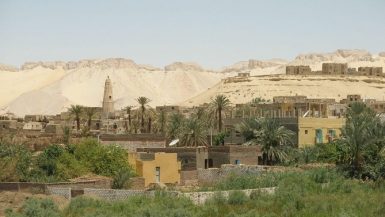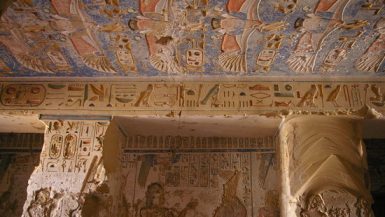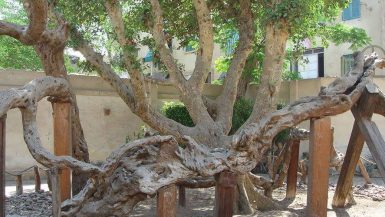Hermopolis West, on the modern site of Tuna el Gebel near Minya, was the necropolis of the city of Hermopolis, sacred to the Greek god Hermes and his Egyptian counterpart Thoth.
It is best known for the sprawling catacombs at the foot of the western cliffs, where thousands of ibises (dedicated to Thoth) and other sacred animals were buried from the New Kingdom through Roman times.
Tuna el Gebel
Besides multitudes of ibises and baboons, the galleries were also used for the burials of fish, pigs, dogs, cats, goats, pelicans, monkeys, falcons, larks, and kestrels, all mummified and placed into pottery jars.
Potsherds and torn and broken mummies are still strewn in the passages today.
Another major attraction of the site is the early Ptolemaic tomb of a high priest of Thoth named Petosiris, decorated with reliefs in a blend of Greek and Egyptian styles. Petosiris’s wooden coffin, exquisitely inlaid with colored glass hieroglyphs, can be seen in the Egyptian Museum.
A number of Roman-era tombs lie to the south. The most famous of these belongs to Isadora, a young woman who drowned in the second century BC. Her mummy lies in a glass case in her tomb.
The oldest monument at Tuna al-Gebel is a stele marking the northwest boundary of Akhenaten’s city at Amarna, partway up a slope north of Hermopolis West. It bears scenes of Akhenaten and Nefertiti worshipping the sun disk (the Aten) and is carved with an extensive text describing the founding of the city.
LOCATION:
7 km west of Hermopolis
DIRECTIONS:
BY TAXI: ask for “tuna al-gebel”
NOTE: Due to heightened security, private taxis are the only reliable way to visit this site. Local police will provide an escort for the vehicle.
The site is not wheelchair accessible.
HOURS OF OPERATION:
Open daily. Summer:
8 AM – 5 PM
Winter: 8 AM – 4 PM
TICKET COST:
Egyptian: 1 LE
Foreign: 15 LE
Reduction for bearers of International Student ID Card





Leave a reply